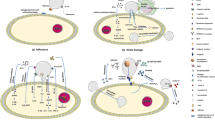Abstract
An antibody for immunohistochemical identification of alveolar type 2 pneumoyctes was prepared by immunization of rabbits with a lamellar-body-enriched fraction of mouse lung homogenate. Following absorption with mouse serum and tissue membrane fractions the antibody preparation was shown to be monospecific by immunodiffusion against delipidated lamellar body proteins. Immunoperoxidase staining of tissues revealed specific labeling of alveolar type 2 pneumoyctes, best demonstrated in acetone-fixed frozen sections, together with staining of the surfactant layer lining most small and medium-sized airways. Immunospecific staining was seen in sections of mouse, rat, and human lung, and clearly demonstrated hypertrophic and hyperplastic type 2 pneumocytes in human fibrosing alveolitis (interstitial pulmonary fibrosis). The antibody also stained cells of a type 2 pneumocyte-related strain derived from normal adult mouse lung. No cross-reactivity with cells of other tissues or in vitro cell lines was observed. The immunostaining pattern is consistent with the notion that the antibody recognizes a surfactant apoprotein. The antibody may usefully be employed as an immunologic marker of the in vivo and in vitro responses of type 2 pneumocytes.
Similar content being viewed by others
References
Balis JU, Paterson JF, Paciga JE, Shelley SA (1982) Ultrastructural localization of human lung surfactant “apoproteins” in type II pneumocytes. Fed Proc 41:1601
Balis JU, Bumgarner SD, Paciga JE, Paterson JF, Shelley SA (1984) Synthesis of lung surfactant-associated glycoproteins by A549 cells: description of an in vitro model for human type II cell dysfunction. Exp Lung Res 6:197–213
Benson BJ, Dobbs LG, Ansfield MJ (1983) Immunopharmacology of lung surfactant. In: Newball HH (ed) Immunopharmacology of the lung. Marcel Dekker, New York, pp 209–241
Bhattacharya SN, Passaro MA, DiAugustine RP, Lynn WS (1975) Isolation and characterization of two hydroxyproline-containing glycoproteins from normal animal lung lavage and lamellar bodies. J Clin Invest 55:914–920
Bradford MM (1976) A rapid and sensitive method for the quantitation of microgram quantities of protein utilizing the principle of protein-dye binding. Anal Biochem 72:248–254
Burley RW (1975) Studies on the apoproteins of the major lipoprotein of the yolk of hen’s eggs. I. Isolation and properties of the low-molecular-weight apoproteins. Aust J Biol Sci 28:121–132
Duck-Chong CG (1978) The isolation of lamellar bodies and their membranous content from rat lung, lamb tracheal fluid and human amniotic fluid. Life Sci 22:2025–2030
Gail DB, Lenfant CJM (1983) Cells of the lung: biology and clinical implications. Am Rev Respir Dis 127:366–387
Katyal SL, Singh G (1979) An immunologic study of the apoproteins of rat lung surfactant. Lab Invest 40:562–567
King RJ, Martin H (1980) Intracellular metabolism of the apoproteins of pulmonary surfactant in rat lung. J Appl Physiol 48:812–820
Kumar RK, Watkins SG, Lykke AWJ (1985) Pulmonary responses to bleomycin-induced injury: an immunomorphologic and electron microscopic study. Exp Pathol (in press)
Mason RJ, Dobbs LG, Greenleaf RD, Williams MC (1977) Alveolar type II cells. Fed Proc 36:2697–2702
Mason RJ, Jones S, Benson BJ, Gikas E, Williams MC, Clements JA (1978) Immunofluorescent localization of purified surface active material in rat lung and isolated type II cells. Clin Res 26:451a
Massaro D (1981) The cellular and molecular basis of pulmonary alveolar stability. J Lab Clin Med 98:155–165
Nathrath WBJ, Rowlatt C, Detheridge F (1981) Localization of organ-specific antigens in mouse lung by light and electron microscopy. J Histochem Cytochem 29:1365–1371
Shelley SA, Balis JU, Paciga JE, Espinoza CG, Richman AV (1982) Biochemical composition of adult human lung surfactant. Lung 160:195–206
Smith GJ, Le Mesurier SM, de Montfort ML, Lykke AWJ (1984) Establishment of epithelial cell strains from normal adult mouse lung resembling a urethane-induced lung adenoma cell strain and a metastasizing mouse lung carcinoma cell line. Cell Biol Int Rep 8:161–169
Sueishi K, Tanaka K, Oda T (1977) Immunoltrastructural study of surfactant system: distribution of specific protein of surface active material in rabbit lung. Lab Invest 37:136–142
Ten-Have Opbroek AAW (1975) Immunological study of lung development in the mouse embryo: appearance of a lung-specific antigen localized in the great alveolar cells. Dev Biol 46:390–403
Williams MC, Benson BJ (1981) Immunocytochemical localization and identification of the major surfactant protein in adult rat lung. J Histochem Cytochem 29:291–305
Author information
Authors and Affiliations
Rights and permissions
About this article
Cite this article
Kumar, R.K., Lykke, A.W.J., Truscott, J.Y. et al. Immunohistochemical identification of type 2 pneumocytes by an antibody to a lamellar body-enriched fraction of lung homogenate. Lung 163, 243–253 (1985). https://doi.org/10.1007/BF02713824
Accepted:
Issue Date:
DOI: https://doi.org/10.1007/BF02713824




